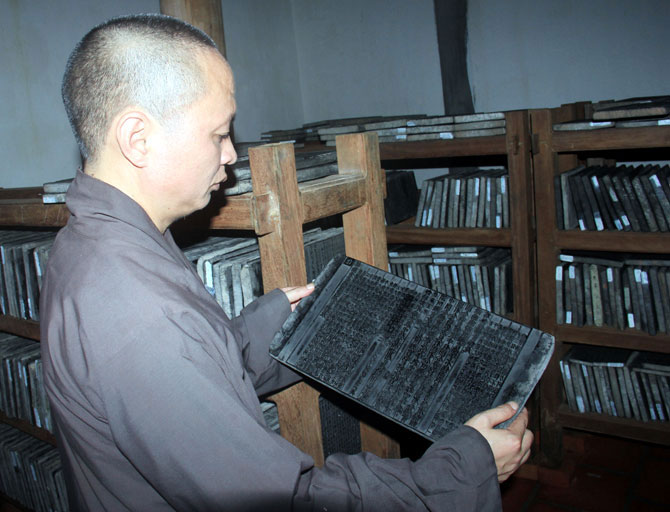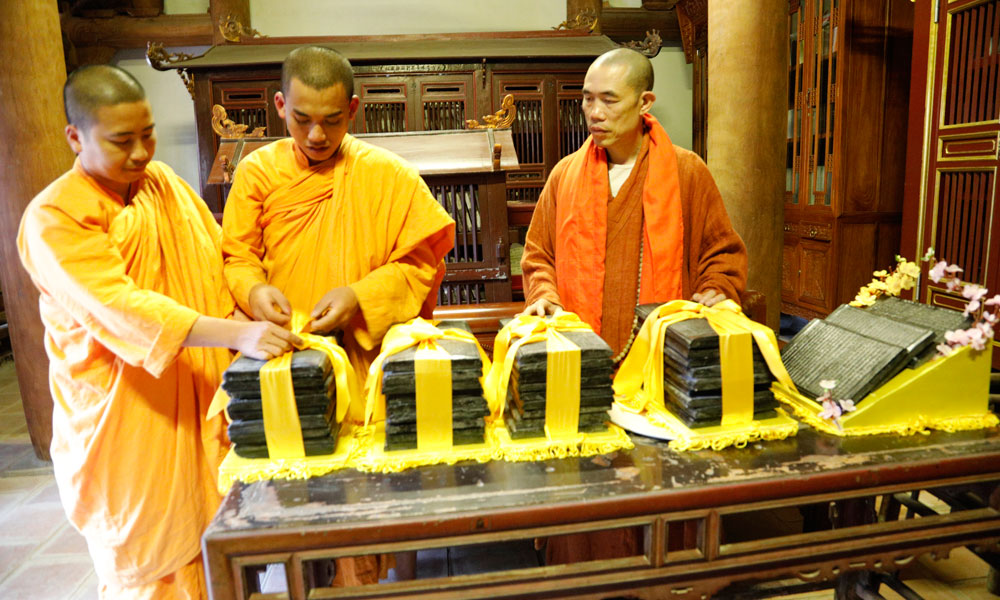(BGO) – Bo Da Pagoda in Tien Son commune, Viet Yen district (Bac Giang), is home to nearly 2,000 woodblocks, which hold historical, religious, cultural, linguistic, literary, artistic and sculptural value. Among them there are woodblocks of “Loi ngu phe” (The King’s Preamble) by Chinese Emperor Yongzheng in June, the 11th year of the Yongzheng reign (1733), and the “Loi dan moi san khac” (The New Preamble) by Vietnamese King Nguyen Duc Tong (titled Tu Duc) in 1855.

|
|
The outer side of the wood book at Bo Da Pagoda – The prayer woodblocks kept at Bo Da.
|
“Ngu che van” is the preamble written by Emperor Yongzheng for a Buddhist book titled “Van thien dong quy”. The characters were engraved in the square style. Each side of the blocks contains 17 text columns, divided into two pages. Each page has eight columns. Between the two pages there was a column for the title of the book and the block’s serial number.
A summary of the composition: The “Van thien dong quy” book comprises tens of thousands of words that were orally transmitted at home and abroad.
“…Thousands, tens of thousands of such words are included in the Dai Tang, and they have been spread overseas. I have ordered selection of them for copy. I cannot help to express my respect and joy…The Monk said that to pursue a religion; one must understand clearly his sect. I have ordered the engraving of the entire book to print the book and grant it to followers. I also considered selecting the appendix in the original version, but then ordered eliminating it due to concerns that new learners may become confused.” The comment was made on the 15th of the sixth month of Quy Suu Year, or the 11th year of the Yongzheng reign.
The “Loi dan moi san khac” (The New Preamble) was written in the At Mao Year (1855) in the Tu Duc reign by King Nguyen Duc Tong. The woodblocks were engraved at Bo Da Pagoda, with the characters in the square style. The following is a summary:

|
|
The woodblocks at Bo Da Pagoda.
|
“I’m not really good at literature, so I could only record the meaning of the old preamble, and add the preface compiled by Emperor Yongzheng in the original version. However, the introduction was more than half missing than the original version. My book was written in spring of the At Mao Year (1855) in the Tu Duc reign (1855). I once visited the head monk at Hai Ninh Pagoda, Kim Thanh, Hai Duong, which belongs to the Bo Da complex, Lam Te sect in Bac Giang province. I had an opportunity to read valuable sutras and discovered that a lot of information was missing from the original version, including the “Van thien dong quy” by Emperor Yongzheng. I saw notes written by monk Khanh Quang, so asked to have the books. Monk Pho Huy presented them with pleasure, but the fifth one was missing. I ordered the search for monk Khanh Quang in pagodas in the country, but no monk with that name was found. Many years later, I visited Xuan Loi Pagoda to meet with patriarch Tam Hoi, and had the chance to read the original version written by monk Vinh Minh. I was so happy, and borrowed it to make five copies.”
Besides their own values, these books hold special meanings as the King himself read and wrote the preamble for them. Through the imperial autograph, readers could see the royal court’s interest in the conservation and development of Buddhism under the Nguyen Dynasty (the 19th century).
The books also feature the introduction of Buddhism into Vietnam from China and India, where Buddhism has a long history of development and has great impacts on Vietnam’s Buddhism, along with the development of Buddhism in Vietnam, including the Bo Da Pagoda of Lam Te sect in Bac Giang province.
Along with the woodblocks at Vinh Nghiem Pagoda, which were recognised as part of the Asia-Pacific documentary heritage under the UNESCO Memory of the World Program, the woodblocks at Bo Da Pagoda have contributed to enriching the documentary heritage repository of Bac Giang in particular and Vietnam in general.
Bo Da Pagoda was recognised as a special national relic site for holding natural, historical, artistic and architectural values, and also for preserving the Buddhist woodblocks of the most ancient Zen sect in Vietnam, Lam Te.
Dong Ngoc Duong


 Bắc giang
Bắc giang









Reader's comments (0)